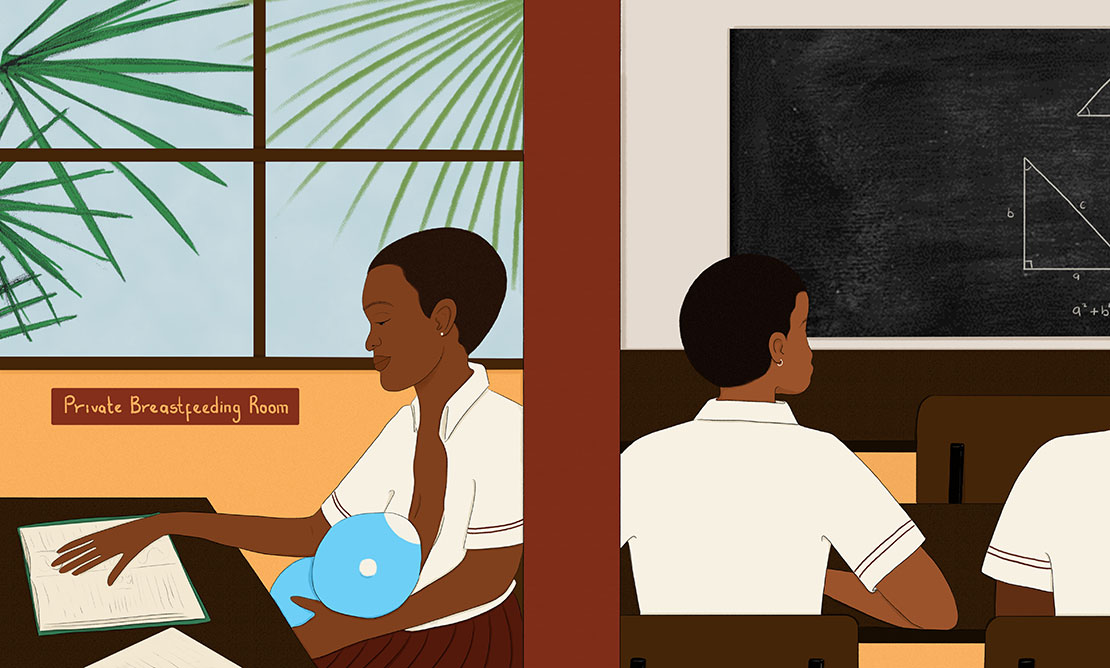

© 2022 Ojima Abalaka for Human Rights Watch
Education Access across the African Union: A Human Rights Watch Index
Each year, across Africa, tens of thousands of adolescent girls drop out of school or experience discrimination and exclusion because they are pregnant, married, or are mothers.
Africa has the highest birth rate among adolescent girls globally. Throughout the Covid-19 pandemic, adolescent pregnancies have surged across many African countries, linked to school closures, lack of protective spaces for girls, and an increase in violence within communities. Likewise, government failures to ensure protections and access to services during lockdowns and closures have contributed to rising cases of child marriage during the pandemic.
Pregnancy is both a barrier to girls continuing their education and often a consequence of girls dropping out of school. Numerous studies have shown that the longer a girl stays in school, the less likely she is to be married as a child or become pregnant during her teenage years.
Poverty, sexual and gender-based violence, and poor health outcomes, combined with lack of access to education, expose thousands of girls to unwanted pregnancies. Measures that tackle these underlying socioeconomic conditions, and empower girls, can play a critical role in addressing high rates of teenage pregnancy.
No one sent me away from school. I stopped studying because of my belly, I felt embarrassed … I didn’t know if they would laugh at me or make jokes because in my classroom even when people have disabilities or show up with dirty, unkempt hair they make jokes and laugh at you.… [S]chool could give us more support so that we don’t have to stop studying because we are ashamed of it and in case we drop out we can get our place back so that we can study again … as well as support with school material such as notebooks and uniforms, and milk and nappies for the baby.
—Dora N., 16, Maputo province, Mozambique
All girls have a right to education, whether or not they are pregnant, mothers, or married. International legal obligations to provide all children with an education, free from discrimination, are clear: Government policies that discriminate against girls because of pregnancy or marriage violate international and regional human rights law, and often infringe on girls’ nationally and constitutionally protected rights.
When an unmarried girl gets pregnant, society condemns her, accuses her. If an unmarried girl becomes pregnant while she is in school, she herself will be ashamed to come to school, because she will be afraid that her classmates, or teachers, will laugh at her or insult her…. It would be good if there were social workers or psychologists in schools to reassure and support young girls, before and after pregnancy. It would also be useful to set up a system so that girls can bring their children with them to school, like a daycare center.
—Mariama Mamoudou, director of programs, ONG FAD Niger
All 55 member states of the African Union have adopted obligations to ensure inclusive and quality education for every student through the adoption of the African Union Agenda 2063 and the United Nations Sustainable Development Goals. African governments have also made commitments to end child marriage, promote sexual and reproductive rights, and tackle teenage pregnancy. Further, all AU states have a duty to protect girls from exclusion in education.
Most African countries have frameworks that explicitly guarantee adolescent girls’ right to stay in school during pregnancy and motherhood. At least 38 African countries have adopted laws, policies, or corresponding measures that ensure that pregnant girls can resume their education after giving birth.
However, many countries lack adequate policies or have adopted punitive or discriminatory measures against adolescent mothers that serve to deny girls the right to complete primary and secondary education. Numerous education systems still choose to punish girls for pregnancy—by denying them any kind of education, forcing them to choose poorer quality education in alternative settings away from their own peers, or stigmatizing them when they fight to stay in school.
Some African countries that lack policies related to teenage pregnancies in schools also impose “morality” based penalties and punishments on girls who are reported to have had sexual relationships outside of marriage. Girls who become pregnant are not only exposed to public ridicule and social stigma, but may also be criminally charged for nonmarital sex, indecency, or adultery.
The lack of positive protections hurts girls, and their communities, and hinders progress toward achieving national and shared AU-wide goals.
Human Rights Watch calls on all African governments to adopt human rights-compliant education policies that guarantee that students who are pregnant or parenting are:
- allowed to remain in school for as long as they choose;
- able to resume their education free from complex processes for withdrawal and re-enrollment;
- supported to complete their education in school environments free from stigma and discrimination and to receive adequate social and financial support to stay in school.
Human Rights Watch has reviewed over 100 official laws and policies relating to education, gender equity strategies, reproductive health plans, and various policies or directives from ministries of education across all African Union member states to understand how African governments protect or hinder access to education for pregnant students and adolescent mothers.
This index presents a comprehensive overview of the various laws, policies, and practices across the African Union. Laws and policies change or are updated periodically. We intend to update this resource, and the interactive maps, periodically to reflect such changes.
Read an accessible version of the interactive index.
State & Country Profiles
SDGs, Targets, and Indicators in the Article
1. Which SDGs are addressed or connected to the issues highlighted in the article?
- SDG 4: Quality Education
- SDG 5: Gender Equality
- SDG 10: Reduced Inequalities
- SDG 16: Peace, Justice, and Strong Institutions
The article discusses the barriers to education faced by pregnant, married, and mother adolescent girls in Africa. These barriers are connected to the goals of achieving quality education (SDG 4), gender equality (SDG 5), reducing inequalities (SDG 10), and ensuring peace, justice, and strong institutions (SDG 16).
2. What specific targets under those SDGs can be identified based on the article’s content?
- SDG 4.1: By 2030, ensure that all girls and boys complete free, equitable, and quality primary and secondary education.
- SDG 4.5: By 2030, eliminate gender disparities in education and ensure equal access to all levels of education and vocational training for the vulnerable, including persons with disabilities, indigenous peoples, and children in vulnerable situations.
- SDG 5.3: Eliminate all harmful practices, such as child, early, and forced marriage and female genital mutilation.
- SDG 10.2: By 2030, empower and promote the social, economic, and political inclusion of all, irrespective of age, sex, disability, race, ethnicity, origin, religion or economic or other status.
- SDG 16.2: End abuse, exploitation, trafficking, and all forms of violence against and torture of children.
Based on the article’s content, the specific targets under the mentioned SDGs include ensuring access to quality education for all girls and boys (SDG 4.1), eliminating gender disparities in education (SDG 4.5), ending child marriage (SDG 5.3), promoting social inclusion (SDG 10.2), and ending violence against children (SDG 16.2).
3. Are there any indicators mentioned or implied in the article that can be used to measure progress towards the identified targets?
Yes, there are indicators mentioned or implied in the article that can be used to measure progress towards the identified targets. These indicators include:
- Adolescent pregnancy rates
- Number of girls dropping out of school due to pregnancy, marriage, or motherhood
- Existence and implementation of laws, policies, or measures that ensure pregnant girls can resume their education after giving birth
- Existence of social workers or psychologists in schools to support young girls before and after pregnancy
- Existence of daycare centers in schools to support girls with children
- Existence of human rights-compliant education policies that guarantee the rights of pregnant or parenting students
These indicators can be used to measure progress towards the targets of ensuring access to education, eliminating gender disparities, ending child marriage, promoting social inclusion, and ending violence against children.
Table: SDGs, Targets, and Indicators
| SDGs | Targets | Indicators |
|---|---|---|
| SDG 4: Quality Education | 4.1: By 2030, ensure that all girls and boys complete free, equitable, and quality primary and secondary education. | – Number of girls dropping out of school due to pregnancy, marriage, or motherhood – Existence and implementation of laws, policies, or measures that ensure pregnant girls can resume their education after giving birth |
| SDG 5: Gender Equality | 5.3: Eliminate all harmful practices, such as child, early, and forced marriage and female genital mutilation. | – Existence of laws, policies, or measures to end child marriage – Number of cases of child marriage |
| 4.5: By 2030, eliminate gender disparities in education and ensure equal access to all levels of education and vocational training for the vulnerable, including persons with disabilities, indigenous peoples, and children in vulnerable situations. | – Number of girls with access to education at all levels – Existence of laws, policies, or measures to eliminate gender disparities in education |
|
| SDG 10: Reduced Inequalities | 10.2: By 2030, empower and promote the social, economic, and political inclusion of all, irrespective of age, sex, disability, race, ethnicity, origin, religion or economic or other status. | – Existence of social workers or psychologists in schools to support young girls before and after pregnancy – Existence of human rights-compliant education policies that guarantee the rights of pregnant or parenting students |
| SDG 16: Peace, Justice, and Strong Institutions | 16.2: End abuse, exploitation, trafficking, and all forms of violence against and torture of children. | – Number of cases of violence against pregnant or parenting girls in schools – Existence of laws, policies, or measures to end violence against children |
Source: hrw.org







